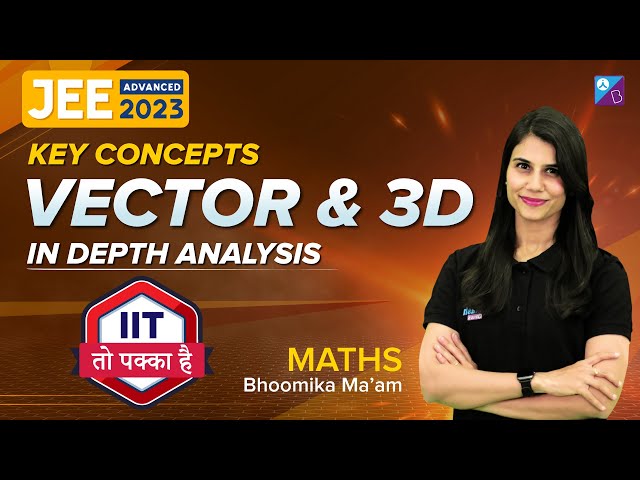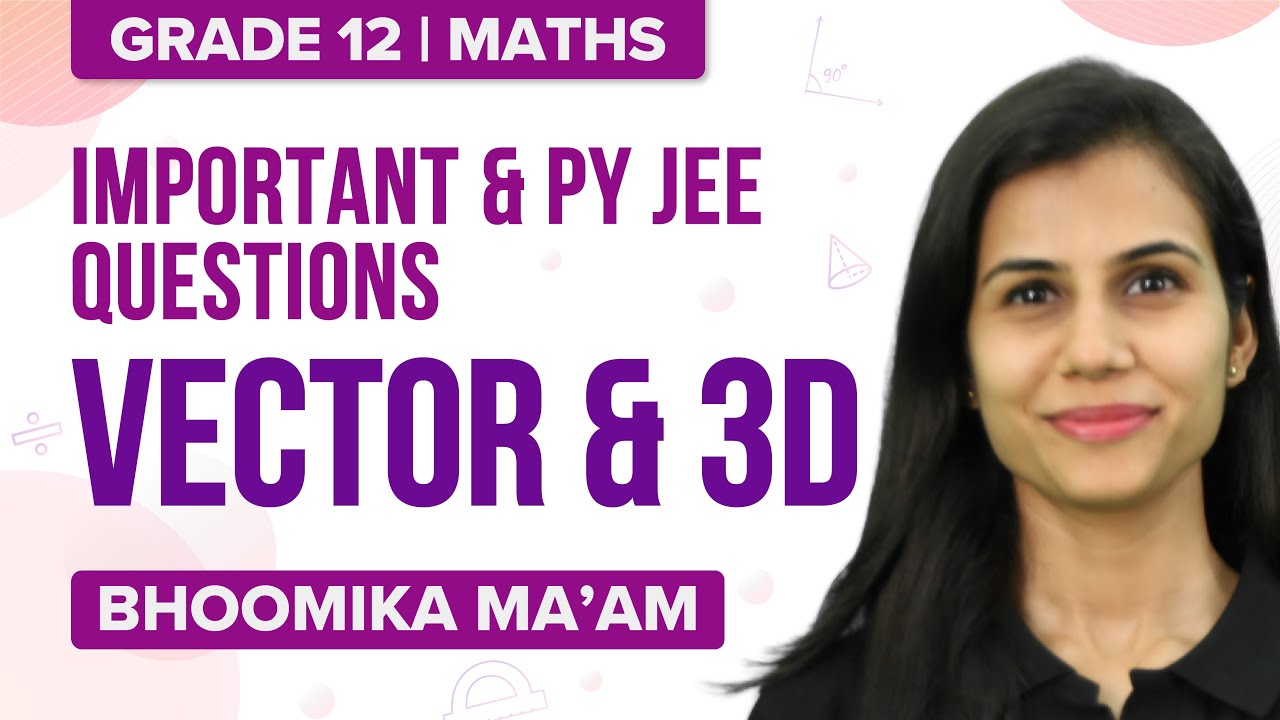Vector JEE Advanced previous year questions with solutions are given on this page. Algebra of vectors, linear dependence and independence of vectors, vector inequality, scalar or dot product of two vectors, cross product, scalar and vector triple product, etc are the important topics in vectors. These chapter-wise solutions are prepared by our subject experts. Learning these solutions will definitely help you to easily crack the problems from vectors for the JEE Advanced exam.
Question 1: \(\begin{array}{l}\text{Let}\ \overrightarrow{PR}=3\hat{i}+\hat{j}-2\hat{k}\ \text{and}\ \overrightarrow{SQ}=\hat{i}-3\hat{j}-4\hat{k}\end{array} \)
determine diagonals of a parallelogram PQRS and \(\begin{array}{l}\overrightarrow{PT}=\hat{i}+2\hat{j}+3\hat{k}\ \text{be another vector}.\end{array} \)
Then the volume of the parallelopiped determined by the vectors \(\begin{array}{l}\overrightarrow{PT},\ \overrightarrow{PQ},\ \text{and}\ \overrightarrow{PS}\ \text{is}\end{array} \)
(a) 5
(b) 20
(c) 10
(d) 30
Solution:
Area of PQRS
\(\begin{array}{l}=\frac{1}{2}\left | \overrightarrow{PR} \times \overrightarrow{SQ}\right |\end{array} \)
\(\begin{array}{l}=\frac{1}{2}\begin{vmatrix} \hat{i} & \hat{j} & \hat{k}\\ 3 & 1 &-2 \\ 1 & -3 & -4 \end{vmatrix}\end{array} \)
\(\begin{array}{l}=5\left | \hat{i}-\hat{j} +\hat{k}\right |\end{array} \)
= 5√3
\(\begin{array}{l}\text{Height} = \text{Projection of PT on}\ \hat{i}-\hat{j} +\hat{k}\end{array} \)
= |(1 – 2 + 3)/√3|
= 2/√3
Volume of parallelopiped = 5√3 × (2/√3)
= 10
Hence option c is the answer.
Question 2: Consider the set of eight vectors \(\begin{array}{l}V = \{a\hat{i}+b\hat{j} +c\hat{k}: a,\ b,\ c\ \text{belongs to}\ \{-1, 1\}\}.\end{array} \)
Three non-coplanar vectors can be chosen from V in 2P ways. Then p is
(a) 5
(b) 4
(c) 6
(d) 7
Solution:
Let a(1, 1, 1), b(−1, 1, 1), c(1, −1, 1), d(−1, −1, 1) be vectors. The rest of the vectors are -a, -b, -c, and -d.
Out of any three coplanar vectors, two will be collinear (anti-parallel).
Number of ways of selecting the anti-parallel pair = 4
Number of ways of selecting the third vector = 6
Total = 24
Number of non-coplanar selections = 8C3 – 24
= 56-24
= 32
= 25
⇒ p = 5
Hence option a is the answer.
Question 3: Let O be the origin and OX, OY, and OZ be three unit vectors in the direction of the sides QR, RP, and PQ, respectively, of a triangle PQR.
If the triangle PQR varies, then the minimum value of cos (P + Q) + cos(Q + R) + cos (R + P) is
(a) 3/2
(b) -3/2
(c) 5/3
(d) -5/3
Solution:
In triangle PQR, P + Q + R = π
P + Q = π – R
Q + R = π – P
P + R = π – Q
cos (π – R) + cos (π – P) + cos (π – Q) = -cos R – cos P – cos Q
To minimize the given expression, we should maximize cos P + cos Q + cos R.
cos P + cos Q + cos R will be maximum when cos P = cos Q = cos R
⇒ P = Q = R = π/3
⇒ PQR is equilateral triangle.
So minimum value = -3 cos π/3
= -3/2
Hence option b is the answer.
Question 4: Let O be the origin and OX, OY, and OZ be three unit vectors in the direction of the sides QR, RP, and PQ, respectively, of a triangle PQR. \(\begin{array}{l}\left | \overrightarrow{OX}\times \overrightarrow{OY} \right |\end{array} \)
equals
(a) sin (Q + R)
(b) sin (P + R)
(c) sin 2R
(d) sin (P + Q)
Solution:
\(\begin{array}{l}\left | \overrightarrow{OX}\times \overrightarrow{OY} \right |=\left |\overrightarrow{OX} \right |\left |\overrightarrow{OY} \right |\sin \theta\end{array} \)
= 1 × 1 × sin θ
= sin (180 – R)
= sin (P + Q)
Hence option d is the answer.
Question 5: \(\begin{array}{l}\text{If a unit vector}\ \vec{a}\ \text{makes angles}\ \frac{\pi}{3}\ \text{with}\ \hat{i},\end{array} \)
\(\begin{array}{l}\frac{\pi}{4}\ \text{with}\ \hat{j}\ \text{and}\ \theta\ \text{belongs to}\ (0, \pi)\ \text{with}\ \hat{k},\end{array} \)
then a value of θ is
(a) 5π/6
(b) π/4
(c) 5π/12
(d) 2π/3
Solution:
Let cos x, cos y, and cos z be the direction cosines of a.
Then cos x = cos π/3, cos y = cos π/4 and cos z = cos θ
⇒ cos2 π/3 + cos2 π/4 + cos2 θ = 1
⇒ cos2θ = ¼
⇒ cos θ = ±1/2
⇒ θ = π/3 or 2π/3
Hence option d is the answer.
Question 6: Let the volume of a parallelopiped whose coterminous edges are given by \(\begin{array}{l}\vec{u}=\hat{i}+\hat{j}+\lambda \hat{k},\ \vec{v}=\hat{i}+\hat{j}+3 \hat{k},\ \text{and}\ \vec{w}=2\hat{i}+\hat{j}+ \hat{k}\end{array} \)
be 1 cu.unit. If θ be the angle between the edges \(\begin{array}{l}\vec{u}\ \text{and}\ \vec{w},\ \text{then}\ \cos\ \theta\ \text{can be}\end{array} \)
(a) 7/6√6
(b) 7/6√3
(c) 5/7
(d) 5/3√3
Solution:
Given that
\(\begin{array}{l}\vec{u}=\hat{i}+\hat{j}+\lambda \hat{k}\end{array} \)
\(\begin{array}{l}\vec{v}=\hat{i}+\hat{j}+3 \hat{k}\end{array} \)
and
\(\begin{array}{l}\vec{w}=2\hat{i}+\hat{j}+ \hat{k}\end{array} \)
Volume of parellelopiped
\(\begin{array}{l}=\left [ \vec{u}.\vec{v}.\vec{w} \right ]\end{array} \)
\(\begin{array}{l}\Rightarrow \pm 1 = \begin{vmatrix} 1 & 1&\lambda \\ 1& 1 &3 \\ 2& 1 & 1 \end{vmatrix}\end{array} \)
⇒ 1(1 – 3) – 1(1 – 6) + λ(1 – 2) = ± 1
⇒ -2 + 5 – λ = ± 1
⇒ 3 – λ = ± 1
⇒ λ = 2 or 4
When λ = 2, cos θ = 5/6
When λ = 4, cos θ = 7/6√3
Hence option b is the answer.
Question 7: Let \(\begin{array}{l}\vec{a}=2\hat{i}+\lambda _{1}\hat{j}+3\hat{k},\ \vec{b}=4\hat{i}+(3-\lambda _{2})\hat{j}+6\hat{k},\ \text{and}\ \vec{c}=3\hat{i}+6\hat{j}+(\lambda _{3}-1)\hat{k}\end{array} \)
\(\begin{array}{l}\text{be three vectors such that}\ \vec{b}=2\vec{a}\end{array} \)
and vector a is perpendicular to vector c. then a possible value of λ1, λ2, λ3 is
(a) (1, 3, 1)
(b) (-½, 4, 0)
(c) (½, 4, -2)
(d) (1, 5, 1)
Solution:
Given that
\(\begin{array}{l}\vec{b}=2\vec{a}\end{array} \)
So 4i + (3 – λ2)j + 6k = 4i + 2λ1j + 6k (i, j, k are the unit vectors)
So (3 – λ2) = 2λ1 ….(i)
Vector a is perpendicular to vector c.
So
\(\begin{array}{l}\vec{a}.\vec{c}=0\end{array} \)
6 + 6λ1 + 3(λ3 – 1) = 0
⇒ 2 + 2λ1 + λ3 – 1 = 0
⇒ λ3 = -2λ1 – 1 ….(ii)
Check the options.
(-½, 4, 0) satisfies (i) and (ii).
So possible value of λ1, λ2, λ3 are (-½, 4, 0).
Hence option b is the answer.
Question 8: If \(\begin{array}{l}\left | \vec{a} \right |=2,\ \left | \vec{b} \right |=3,\ \text{and}\ \left | 2\vec{a} -\vec{b} \right |=5,\end{array} \)
\(\begin{array}{l}\text{then}\ \left | 2\vec{a} +\vec{b} \right |\ \text{equals}\end{array} \)
(a) 17
(b) 7
(c) 5
(d) 1
Solution:
Given that
\(\begin{array}{l}\left | 2\vec{a} -\vec{b} \right |=5\end{array} \)
\(\begin{array}{l}\sqrt{(2\left | \vec{a} \right |)^{2}+\left | \vec{b} \right |^{2}-2\times \left | 2\vec{a} \right |\left | \vec{b} \right |\cos \theta }=5\end{array} \)
\(\begin{array}{l}\text{Putting the values of}\ \left | \vec{a} \right |\ \text{and}\ \left | \vec{b} \right |,\ \text{we get};\end{array} \)
(2 × 2)2 + 32 – 24 cos θ = 25
⇒ cos θ = 0
⇒ θ = π/2
So
\(\begin{array}{l}\left | 2\vec{a}+\vec{b} \right |\end{array} \)
= √(16 + 9 + 24 cos θ)
= √25
= 5
Hence option c is the answer.
Question 9: \(\begin{array}{l}\text{If}\ \vec{x}\ \text{and}\ \vec{y}\ \text{be two non zero vectors such that}\end{array} \)
\(\begin{array}{l}\left |\vec{x}+\vec{y} \right |=\left | \vec{x} \right |\ \text{and}\ 2\vec{x}+\lambda \vec{y}\end{array} \)
\(\begin{array}{l}\text{is perpendicular to}\ \vec{y},\ \text{then the value of}\ \lambda\ \text{is}\end{array} \)
Solution:
Given
\(\begin{array}{l}\left |\vec{x}+\vec{y} \right |=\left | \vec{x} \right |\end{array} \)
Squaring both sides
\(\begin{array}{l}\left | \vec{x}\right |^{2}+2\vec{x}.\vec{y}+\left | \vec{y}\right |^{2}=\left | \vec{x}\right |^{2}\end{array} \)
\(\begin{array}{l}\Rightarrow 2\vec{x}.\vec{y}+\vec{y}.\vec{y}=0….(i)\end{array} \)
\(\begin{array}{l}\Rightarrow 2\vec{x}+\lambda \vec{y}=0\end{array} \)
\(\begin{array}{l}\text{Also given}\ 2\vec{x}+\lambda \vec{y}\ \text{is perpendicular to}\ \vec{y}\end{array} \)
\(\begin{array}{l}2\vec{x}.\vec{y}+\lambda \vec{y}.\vec{y}=0….(ii)\end{array} \)
Comparing (i) and (ii), we get;
λ = 1
Question 10: Let the vectors a, b, c be such that \(\begin{array}{l}\left | \vec{a} \right |=2, \left | \vec{b} \right |=4, \left | \vec{c} \right |=4.\end{array} \)
If the projection of vector b on vector a is equal to the projection of vector c on vector a and vector b is perpendicular to vector c, \(\begin{array}{l}\text{then the value of}\ \left | \vec{a}+ \vec{b}-\vec{c}\right |\ \text{is}\end{array} \)
Solution:
Given
\(\begin{array}{l}\left | \vec{a} \right |=2, \left | \vec{b} \right |=4, \left | \vec{c} \right |=4\end{array} \)
Given that the projection of vector b on vector a is equal to the projection of vector c on vector a.
b.a/|a| = c.a/|a|
⇒ b.a = c.a
Since vector b is perpendicular to vector c
b.c = 0
\(\begin{array}{l}\left | \vec{a}+ \vec{b}-\vec{c}\right |\end{array} \)
= √(a2 + b2 + c2 + 2a.b – 2b.c – 2a.c)
= √(4 + 16 + 16)
= 6
Also Read
JEE Main Maths Vector Algebra Previous Year Questions With Solutions
Recommended Videos
Vectors and 3D – JEE Advanced PY Questions
Most Important JEE Advanced Problems of Vector Algebra & 3D Geometry
Top JEE Advanced Problems from Vector Algebra
Most Important Questions Vector & 3D
Important Topics from Vector & 3D





Comments